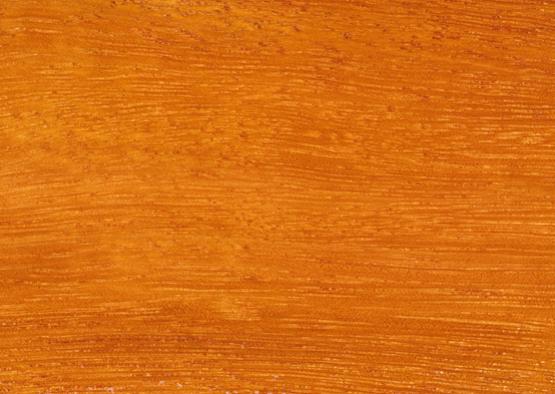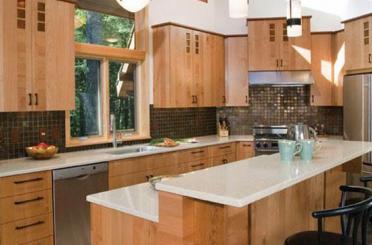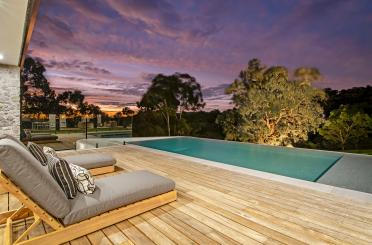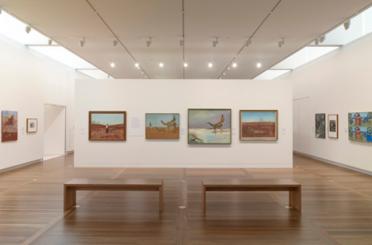Karri is a slow-growing, durable Australian hardwood that produces an interlocked grain and ranges from creamy to red-brown in colour.

Karri is a hardwood timber native to Australia. With its durability and distinctive red hues it is suited to a broad range of applications. Most commonly used in construction, it is also valued by designers in the manufacture of indoor and outdoor furniture. Karri timber also features in the design of indoor and outdoor joinery.
Karri trees are native to the southwest corner of Western Australia, but are also cultivated in plantations internationally. As one of Australia's tallest hardwoods, karri trees grow to a height of between 45 and 70 metres and are found in areas of high rainfall. Their botanical name derives from the tendency, as their dark bark is shed, for the predominantly white trunks to take on a patina of colours from white to grey to deep brown.
Karri timber has an appealing golden appearance. The heartwood varies from reddish browns through to pale pink hues with the sapwood being a clearly distinguishable creamy white. It is moderately durable, but resists impregnation with preservatives or other treatments. The sapwood is susceptible to borer attack and is known to be susceptible to termites.
Karri is currently used extensively for flooring, panelling and internal joinery. Its strength and appearance has a wide appeal for fine furniture designers. It has been used extensively for general construction, framing, joists, shipbuilding, sleepers, guides or side beams in mines, structural plywood, roofing timbers and pulp and paper. Greater lengths are available than from any other Western Australian hardwood. The timber also lends itself to use in roofing because it can be milled in extensive lengths that are uninterrupted by knots.
Karri makes a versatile and aesthetically pleasing decking board based on its natural durability and bushfire resistance properties (BAL 12.5 and 10 per all AS3959 applications; BAL 29 when used in conjunction with non-combustible wall cladding and enclosed subfloor. A copy of the EWFA Certificate of assessment can be downloaded here.
Shrinkage
| Very Low | Low | Medium | High | Very High | |
|---|---|---|---|---|---|

|

|
||||
Tangential : |
9.90%
|
||||
Radial : |
4.30%
|
||||
Unit Movement Tangential: |
0.40%
|
||||
Unit Movement Radial: |
0.27%
|
Strength Group

Very High |
High |
Reasonably High |
Medium High |
Medium |
Reasonably Low |
Low |
Very Low |
||
Unseasoned: |
S1 |
S2 |
S3 |
S4 |
S5 |
S6 |
S7 |
S8 |
|
|---|---|---|---|---|---|---|---|---|---|
 |
|||||||||
Seasoned: |
SD1 |
SD2 |
SD3 |
SD4 |
SD5 |
SD6 |
SD7 |
SD8 |
|
 |
Stress Grade

| Structural No. 1 |
Structural No. 2 |
Structural No. 3 |
Structural No. 4 |
Structural No. 5 |
|
Unseasoned: |
F17 |
F14 |
F11 |
F8 |
F7 |
Seasoned: |
F34 |
F27 |
F22 |
F17 |
F14 |
Density per Standard

Seasoned: |
900kg/m3
|
|---|---|
Unseasoned: |
1150kg/m3
|
Joint Group

Very High |
High |
Reasonably High |
Medium |
Low |
Very Low |
|
Unseasoned: |
J1 |
J2 |
J3 |
J4 |
J5 |
J6 |
|---|---|---|---|---|---|---|
 |
||||||
Seasoned: |
JD1 |
JD2 |
JD3 |
JD4 |
JD5 |
JD6 |
 |
Colour

| White, yellow, pale straw to light brown | Pink to pink brown | Light to dark red | Brown, chocolate, mottled or streaky | |
 |
||||
Mechanical Properties
Modulus of Rupture - Unseasoned: |
73
|
|---|---|
Modulus of Rupture - Seasoned: |
132
|
Modulus of Elasticity - Unseasoned: |
14
|
Modulus of Elasticity - Seasoned: |
19
|
Maximum Crushing Strength - Unseasoned:  |
36
|
Maximum Crushing Strength - Seasoned: |
72
|
Impact - Unseasoned: |
21
|
Impact - Seasoned: |
24
|
Toughness - Unseasoned: |
Medium - 15 - 24 Nm
|
Toughness - Seasoned: |
Medium - 15 - 24 Nm
|
Hardness - Unseasoned: |
6.0
|
Hardness - Seasoned: |
9.0
|
Durability
| Low | Moderate | Reasonably High | High | |
| (0 - 5 yrs) | (5 - 15 yrs) | (15 - 25 yrs) | (more than 25 yrs) | |
In-Ground: |
 |
|||
| (0 - 7 yrs) | (7 - 15 yrs) | (15 - 40 yrs) | (More than 40 yrs) | |
Above ground: |
 |
|||
| (0 - 20 yrs, usually < 5) | (21 - 40 yrs) | (41 - 64 yrs) | (More than 60 yrs) | |
Marine Borer Resistance: |
 |
Lyctid Borer Susceptibility: |
Not Susceptible |
|---|---|
Lyctid Borer Susceptibility - Other: |
|
Termite Resistance: |
Not Resistant
|
Fire Properties
| 0 | 1 | 2 | 3 | 4 | 5 | 6 | 7 | 8 | 9 | 10 | 11 | 12 | 13 | 14 | 15 | 16 | 17 | 18 | 19 | 20 | |
EFH Ignitibility: |
| 0 | 1 | 2 | 3 | 4 | 5 | 6 | 7 | 8 | 9 | 10 | |
EFH Spread-of-Flame Index: |
|||||||||||
EFH Smoke-Developed Index: |
Critical Radiance Flux - Lower: |
>2.2 and <4.5 |
|---|---|
Critical Radiance Flux - Higher: |
≥4.5 |
Smoke Development Rate: |
<750
|
| 1 - non-combustible | 2 - reasonably non-combustible | 3 - slightly combustible | 4 - combustible | |
Fire Properties Group |
Average Specific Extinction Area: |
<250
|
|---|---|
Bushfire Resistance: |
BAL 12.5 and 19 – All AS3959 required applications, BAL 29 - Decking (in conjunction with non-combustible wall cladding and enclosed subfloor). See link to Certificate of Assessment under Overview tab.
|
Karri is a lustrous timber known for its distinctive red-brown heartwood, which is lighter in colour than jarrah. Its sapwood grows in a narrow band, and is pale and easily distinguished from the heartwood. The grain of the timber can be slightly interlocked or straight, with a somewhat course texture.
The timber of the karri tree has a number of common construction applications including flooring, paneling and joinery. Karri is also suitable for framing and in structural plywood. High quality furniture can be produced with karri timber and the distinctive colour and figure of the timber, along with its durability makes it sought after for this purpose.
Treated timber is used for exposed framing and decking. Its structural uses include wharf and bridge construction, cross-arms, rafters and joists. Other applications include pulp and paper, veneer, railway-carriage construction, agricultural implements and shipbuilding.
Karri timber can be difficult to work because of its heaviness and density. It requires some pre-drilling when nailing, is not able to be readily glued and has a poor reputation for holding paint. Planers must be set to an angle of 15 degrees when dressing, and the when moulded, the timber requires additional sanding.
While relatively durable the timber is susceptible to termites and is not recommended for in ground use. Heartwood timber is not easily manageable, partly because of its interlocking grains, as well as its high density. The heartwood does not accept preservative impregnation.

Joinery

Decking

Flooring

A. Lewis & Co. PTY LTD
Allied Forest Products

Allmat Timber
Austim Pty Ltd
Australian Timber

Classy Timber Flooring

Dromana Discount Timber

Fewings Joinery Pty Ltd

Floors of Distinction
Franz Building Supplies

George Fethers & Co.

Heritage Fencing

Market Timbers

Mathews Timber Pty Ltd

Matilda Veneer

Parkside Timber

Recycled Timber Company

Ridgewood Timber Pty Ltd

Three(3)DM Pty Ltd

Timber Blitz Pty Ltd

Timber Revival










